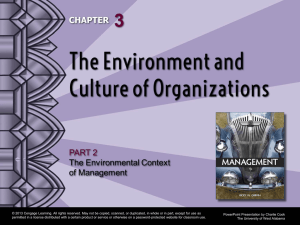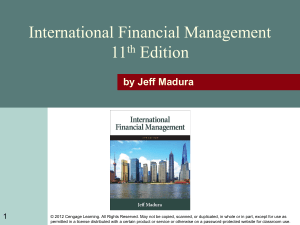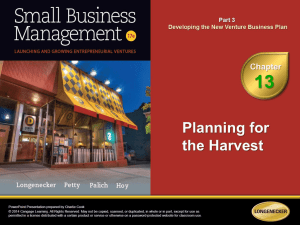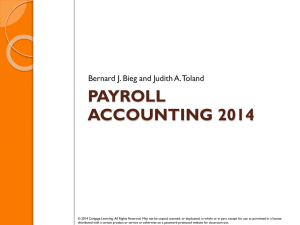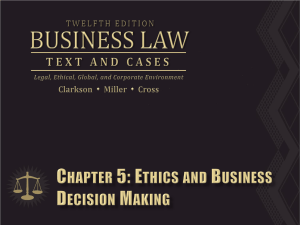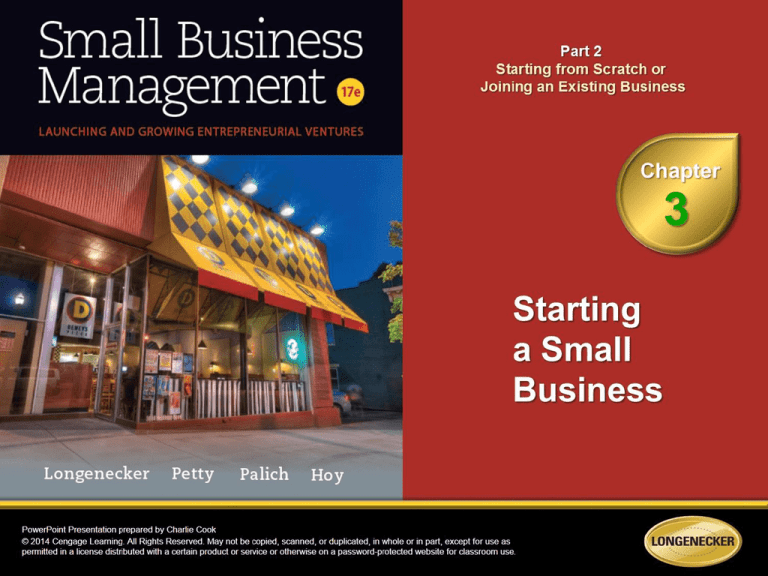
1. Distinguish among the different types and
sources of startup ideas.
2. Use innovative thinking to generate ideas
for high-potential startups.
3. Describe external and internal analyses that might
shape the selection of venture opportunities.
4. Explain broad-based strategy options and focus
strategies.
5. Know how to screen business ideas to identify those
with the greatest potential.
6. Assess the feasibility of a startup idea.
© 2014 Cengage Learning. All Rights Reserved. May not be copied, scanned, or duplicated, in whole or in part, except for use as
permitted in a license distributed with a certain product or service or otherwise on a password-protected website for classroom use.
3–2
Developing Startup Ideas
• Opportunity Recognition
Identification of potential new products or services
that may lead to promising businesses
• Entrepreneurial Alertness
Readiness to act on unnoticed business opportunities
and to pivot quickly away from flawed initial ideas.
• Which Product or Service?
Serves important consumer needs
Has readily recognized utility and user benefits
Is affordable to a large group of potential customers
A good idea is not the same as a good opportunity.
© 2014 Cengage Learning. All Rights Reserved. May not be copied, scanned, or duplicated, in whole or in part, except for use as
permitted in a license distributed with a certain product or service or otherwise on a password-protected website for classroom use.
3–3
Creating a New Business from Scratch
To tap into
unique
resources
that are
available
To develop a
commercial
market for
new product
or service
Motivations
To Start
a Business
Wanting the
challenge of
succeeding
(or failing)
on your own
© 2014 Cengage Learning. All Rights Reserved. May not be copied, scanned, or duplicated, in whole or in part, except for use as
permitted in a license distributed with a certain product or service or otherwise on a password-protected website for classroom use.
To avoid
undesirable
features of
existing
companies
3–4
3.1
Types of Ideas That Develop into Startups
© 2014 Cengage Learning. All Rights Reserved. May not be copied, scanned, or duplicated, in whole or in part, except for use as
permitted in a license distributed with a certain product or service or otherwise on a password-protected website for classroom use.
3–5
3.2
Common Sources of Startup Ideas
Prior work
experience
45%
Personal
interest/hobby
16%
Chance
happening
11%
Suggestion
7%
© 2014 Cengage Learning. All Rights Reserved. May not be copied, scanned, or duplicated, in whole or in part, except for use as
permitted in a license distributed with a certain product or service or otherwise on a password-protected website for classroom use.
Education/
Family
business
Friends/
6%
relatives
5%
Other
4%
3–6
Change-Based Sources of
Entrepreneurial Opportunities
Change Factor
Definition
Industry or Enterprise Factors
The unexpected
Unanticipated events lead to either enterprise success or
failure.
The incongruous
What is expected is out of line with what will work.
Process needs
Current technology is insufficient to address an emerging
challenge.
Structural change
Changes in technology, markets, etc., alter industry dynamics.
Human and Economic Factors
Demographics
Shifts in population size, age structure, ethnicity, and income
distribution impact product demand.
Changes in perception
Perceptual variations determine product demand.
New knowledge
Learning opens the door to new product opportunities with
commercial potential.
© 2014 Cengage Learning. All Rights Reserved. May not be copied, scanned, or duplicated, in whole or in part, except for use as
permitted in a license distributed with a certain product or service or otherwise on a password-protected website for classroom use.
3–7
Using Innovative Thinking to Generate Business Ideas
1. Borrow ideas from existing products and services or other industries.
2. Combine two businesses into one to create a market opening.
3. Begin with a problem in mind.
4. Recognize a hot trend and ride the wave.
5. Explore ways to improve an existing product or service’s function.
6. Think of how to streamline a customer’s activities.
7. Adapt a product or service to meet customer needs in different ways.
8. Imagine how market for a product or service could be expanded.
9. Study a product or service to see if you can make it “green.”
10.Keep an eye on new technologies.
© 2014 Cengage Learning. All Rights Reserved. May not be copied, scanned, or duplicated, in whole or in part, except for use as
permitted in a license distributed with a certain product or service or otherwise on a password-protected website for classroom use.
3–8
Using Internal and External Analyses
to Assess Business Ideas
• Outside-In Analysis
Studying context of venture to identify and determine
business ideas that qualify as opportunities.
General Environment
– Encompasses factors influencing business in a society.
Industry Environment
– Factors that impact a firm and all of its competitors.
Competitive Environment
– Focus on the strength, position, and likely moves and
countermoves of competitors in an industry.
© 2014 Cengage Learning. All Rights Reserved. May not be copied, scanned, or duplicated, in whole or in part, except for use as
permitted in a license distributed with a certain product or service or otherwise on a password-protected website for classroom use.
3–9
3.3
Trends in the General Environment
© 2014 Cengage Learning. All Rights Reserved. May not be copied, scanned, or duplicated, in whole or in part, except for use as
permitted in a license distributed with a certain product or service or otherwise on a password-protected website for classroom use.
3–10
3.4
Major Factors Offsetting Market Attractiveness
© 2014 Cengage Learning. All Rights Reserved. May not be copied, scanned, or duplicated, in whole or in part, except for use as
permitted in a license distributed with a certain product or service or otherwise on a password-protected website for classroom use.
3–11
The Competitive Environment
• Who would be the new venture’s current competitors?
• What unique resources do they control?
• What are their strengths and weaknesses?
• How will they respond to the new venture’s decision to
enter the industry?
• How can the new venture respond?
• Who else might see and exploit the same opportunity?
• Are there ways to co-opt potential or actual competitors
by forming alliances?
© 2014 Cengage Learning. All Rights Reserved. May not be copied, scanned, or duplicated, in whole or in part, except for use as
permitted in a license distributed with a certain product or service or otherwise on a password-protected website for classroom use.
3–12
Evaluating Market Opportunities
• Inside-Out Analysis
Assessing the firm’s internal competitive potential
• Resources
Basic inputs that a firm uses to conduct its business
Tangible resources: visible and easy to measure.
Intangible resources: invisible, difficult to quantify
• Capabilities
Routines and processes that can coordinate the combined use
of productive assets in order to achieve desired outcomes.
• Core Competencies
Capabilities that provide a firm with a competitive advantage
over its rivals and reflect its personality.
© 2014 Cengage Learning. All Rights Reserved. May not be copied, scanned, or duplicated, in whole or in part, except for use as
permitted in a license distributed with a certain product or service or otherwise on a password-protected website for classroom use.
3–13
Integrating Internal and External Analyses
• Strengths, Weaknesses, Opportunities, and
Threats (SWOT) Analysis
Provides concise overview of firm’s strategic situation.
Helps identify opportunities that match the venture.
• Seeking Competitive Insight
Will the opportunity lead to others in the future?
Will the opportunity build skills that open the door to
new opportunities in the future?
Will pursuit of the opportunity be likely to lead to
competitive response by potential rivals?
© 2014 Cengage Learning. All Rights Reserved. May not be copied, scanned, or duplicated, in whole or in part, except for use as
permitted in a license distributed with a certain product or service or otherwise on a password-protected website for classroom use.
3–14
3.5
Examples of SWOT Factors
© 2014 Cengage Learning. All Rights Reserved. May not be copied, scanned, or duplicated, in whole or in part, except for use as
permitted in a license distributed with a certain product or service or otherwise on a password-protected website for classroom use.
3–15
3.6
The Entrepreneur’s Opportunity “Sweet Spot”
© 2014 Cengage Learning. All Rights Reserved. May not be copied, scanned, or duplicated, in whole or in part, except for use as
permitted in a license distributed with a certain product or service or otherwise on a password-protected website for classroom use.
3–16
Important Strategic Terms
• Strategy
Plan of action that coordinates resources and
commitments of an organization to achieve superior
performance.
• Strategic Decision
Regards the direction a firm will take in relating to its
customers and competitors.
• Sustainable Competitive Advantage
A value-creating industry position likely to endure
over time.
© 2014 Cengage Learning. All Rights Reserved. May not be copied, scanned, or duplicated, in whole or in part, except for use as
permitted in a license distributed with a certain product or service or otherwise on a password-protected website for classroom use.
3–17
Selecting Strategies That Capture Opportunities
Broad-Based
Strategy Options
DifferentiationBased Strategy
Cost-Based
Strategy
© 2014 Cengage Learning. All Rights Reserved. May not be copied, scanned, or duplicated, in whole or in part, except for use as
permitted in a license distributed with a certain product or service or otherwise on a password-protected website for classroom use.
Focus
Strategy
3–18
Focus Strategies
• Focus Strategy Implementation
Restricting focus to a single subset of customers.
Emphasizing a single product or service.
Limiting the market to a single geographical region.
Concentrating on superiority of product or service.
© 2014 Cengage Learning. All Rights Reserved. May not be copied, scanned, or duplicated, in whole or in part, except for use as
permitted in a license distributed with a certain product or service or otherwise on a password-protected website for classroom use.
3–19
Focus Strategies (cont’d)
• Advantages
Niche market shields from direct competition.
Focus allows development of unique expertise.
• Disadvantages
Focus markets can quickly erode if:
Competitors
successfully imitate the strategy.
Segment erodes or demand disappears.
Segment loses its uniqueness
New firms subsegment the industry.
© 2014 Cengage Learning. All Rights Reserved. May not be copied, scanned, or duplicated, in whole or in part, except for use as
permitted in a license distributed with a certain product or service or otherwise on a password-protected website for classroom use.
3–20
Factors in Business Idea Screening
Strength of the
business idea
Targeted market
and customers
Capability of
founders
Industry and
competitive
advantage
Screening
a Business
Idea
Capital requirements
and venture
performance
© 2014 Cengage Learning. All Rights Reserved. May not be copied, scanned, or duplicated, in whole or in part, except for use as
permitted in a license distributed with a certain product or service or otherwise on a password-protected website for classroom use.
3–21
Is Your Startup Idea Feasible?
Market
Factors
Fatal
Flaws
Management
Capability
Judging the
Feasibility of
a Business
Opportunity
Competitive
Advantage
Industry
Attractiveness
© 2014 Cengage Learning. All Rights Reserved. May not be copied, scanned, or duplicated, in whole or in part, except for use as
permitted in a license distributed with a certain product or service or otherwise on a password-protected website for classroom use.
3–22
Is Your Startup Idea Feasible?
• Feasibility Analysis
A preliminary assessment of a business idea that
gauges whether or not the venture envisioned is likely
to succeed
• Fatal Flaws
A circumstance or development that alone could
render a new business unsuccessful
Market potential: acceptance, accessibility, growth, and size
Power of competitors
Strength of competitive advantage
Startup costs
Management capability
© 2014 Cengage Learning. All Rights Reserved. May not be copied, scanned, or duplicated, in whole or in part, except for use as
permitted in a license distributed with a certain product or service or otherwise on a password-protected website for classroom use.
3–23
3.7
A Feasibility Analysis Framework
© 2014 Cengage Learning. All Rights Reserved. May not be copied, scanned, or duplicated, in whole or in part, except for use as
permitted in a license distributed with a certain product or service or otherwise on a password-protected website for classroom use.
3–24
Feasibility?… (cont’d)
• New Venture Leadership
Dimensions of Management Capability
1. Fit of the venture with leader’s mission,
aspirations, and comfort level with risk
involved
2. Leader’s grasp of critical enterprise
success factors and ability to execute
on these factors
3. Leader’s connection to others who will be
essential to making the venture work.
© 2014 Cengage Learning. All Rights Reserved. May not be copied, scanned, or duplicated, in whole or in part, except for use as
permitted in a license distributed with a certain product or service or otherwise on a password-protected website for classroom use.
3–25
Key Terms
capabilities
competitive advantage
competitive environment
core competencies
cost-based strategy
differentiation-based strategy
entrepreneurial alertness
fatal flaw
feasibility analysis
focus strategy
general environment
industry environment
intangible resources
new benefit ideas
new market ideas
new technology ideas
opportunity recognition
pivot
resources
serendipity
startups
strategy
SWOT analysis
tangible resources
© 2014 Cengage Learning. All Rights Reserved. May not be copied, scanned, or duplicated, in whole or in part, except for use as
permitted in a license distributed with a certain product or service or otherwise on a password-protected website for classroom use.
3–26




